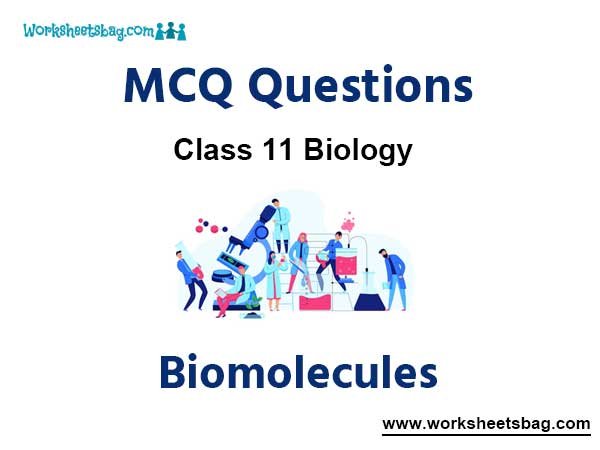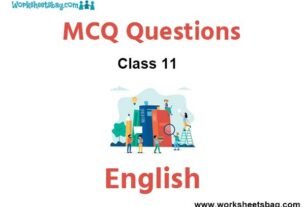Please refer to Biomolecules MCQ Questions Class 11 Biology below. These MCQ questions for Class 11 Biology with answers have been designed as per the latest NCERT, CBSE books, and syllabus issued for the current academic year. These objective questions for Biomolecules will help you to prepare for the exams and get more marks.
Biomolecules MCQ Questions Class 11 Biology
Please see solved MCQ Questions for Biomolecules in Class 11 Biology. All questions and answers have been prepared by expert faculty of standard 11 based on the latest examination guidelines.
MCQ Questions Class 11 Biology Biomolecules
Question- Select the incorrect statement.
(a) Amino acids are substituents methanes.
(b) Glycerol is a trihydroxy propane.
(c) Lysine is a neutral amino acid.
(d) Lecithin is a phospholipid.
Answer
A
Question- Who coined the term zymase?
(a) Pasteur
(b) Buchner
(c) Kuhne
(d) Sumner
Answer
B
Question- Primary structure of protein is due to the presence of______.
(a) hydrogen bonds
(b) peptide bonds
(c) – S – S – linkages
(d) ionic bonds
Answer
A
Question- Gamma globulins are synthesized inside
(a) liver
(b) kidney
(c) bone marrow
(d) lymph and lymphoid tissues
Answer
A
Question- Which of the following statement is not true about amino acid?
(a) The amino group and carboxylic group of an amino acid are attached to both amino and carboxylic groups to alpha carbon.
(b) Amino acids have an N-terminus, C-terminus, and R groups.
(c) Amino acid can be classified by the number of peptide bond.
(d) Essential amino acids are not synthesized in the body, therefore have to be provided in the diet.
Answer
B
Question- Which of the following gives Fehling’s test?
(a) Pectin
(b) Sucrose
(c) Cellulose
(d) Glucose
Answer
D
Question- Which of the following statement is wrong regarding chitin?
(a) It is a storage of polysaccharide.
(b) It is a heteropolysaccharide.
(c) It is a constituent of arthropods and fungal cell wall.
(d) It is a second most abundant carbohydrate on earth.
Answer
D
Question- The nicotinamide is synthesized in our body from
(a) tryptophan
(b) tryosine
(c) valine
(d) alanine
Answer
A
Question- An example of competitive inhibition of an enzyme is the inhibition of
(a) succinic dehydrogenase by malonic acid
(b) cytochrome oxidase by cyanide
(c) hexokinase by glucose-6-phosphate
(d) carbonic anhydrase by carbon dioxide
Answer
A
Question- Inorganic catalyst work efficiently at_______temperature and ________ pressure.
(a) high, low
(b) low, low
(c) low, high
(d) high, high
Answer
D
Question- Which of the following set of three items are not true as each set belongs to the category mentioned against them
(a) Lysine, glycine, thiamine – Amino acids
(b) Myosin, oxytocin and gastrin – Hormones
(c) Rennin, helicase and hyaluronidase -Enzyme
(d) Optic nerve, occulomotor, vagus – Sensory nerves
Answer
C
Question- The simplest amino acid is _________.
(a) glycine
(b) proline
(c) leucine
(d) tryptophan
Answer
C
Question- Alpha-keratin is a protein present in
(a) blood
(b) skin
(c) lymph
(d) eggs
Answer
B
Question- Which one of the following statements is correct, with reference to enzymes ?
(a) Holoenzyme = Apoenzyme + Coenzyme
(b) Coenzyme = Apoenzyme + Holoenzyme
(c) Holoenzyme = Coenzyme + Co-factor
(d) Apoenzyme = Holoenzyme + Coenzyme
Answer
B
Question- Which one of the following statements regarding starch and cellulose is not correct?
(a) Both of them are of plant origin.
(b) Both of them are polymers.
(c) Both of them give colour with iodine.
(d) Both of them are made up of glucose molecules.
Answer
C
Question- Which of the following type of enzyme is not matched correctly with the molecule that it breaks down?
(a) Amylase–starch
(b) Lipase–starch
(c) Protease–proteins
(d) Disaccharidase–sugars
Answer
B
Question- The Km value of the enzyme is the value of the substrate concentration at which the reaction reaches to
(a) Zero
(b) 2 Vmax
(c) ½ Vmax
(d) ¼ Vmax
Answer
C
Question- Turn over number of enzyme depends upon
(a) size of enzyme molecule.
(b) number of the active sites.
(c) concentration of substrate molecule.
(d) molecular weight of as enzyme.
Answer
D
Question-Nucleotides are building blocks of nucleic acids.Each nucleotide is a composite molecule formed by
(a) base-sugar-phosphate.
(b) base-sugar-OH.
(c) (base-sugar-phosphate)n.
(d) sugar-phosphate.
Answer
A
Question- The acid used for preliminary separation of biomolecule in a living tissue is
(a) trichlorobenzoic acid
(b) benzoic acid
(c) trichloroacetic acid
(d) acetic acid
Answer
D
Question- Biomolecules are
(a) organic compounds
(b) inorganic compounds
(c) volatile compounds
(d) both (a) and (b)
Answer
B
Question- All the following amino acids are aromatic, except
(a) tyrosine
(b) phenylalanine
(c) tryptophan
(d) valine
Answer
D
Question- Which statement is true?
(a) Adenine has 4 nitrogen atoms.
(b) Cytosine has 3 nitrogen atoms.
(c) Guanosine has 3 nitrogen atoms.
(d) Uracil has 5 nitrogen atoms.
Answer
A
Question- The most basic amino acid is
(a) arginine
(b) histidine
(c) glycine
(d) glutamine
Answer
D
Question- The charged molecule which is electrically neutral is known as
(a) amino acid
(b) zwitterion
(c) amide
(d) peptide
Answer
D
Question- Which of the following statement is incorrect ?
(a) Long chain molecules of fatty acids are formed by polymerization of 2 carbon compounds.
(b) Lipid molecules are soluble in water.
(c) In lipid, R group may be –CH3 group, –C2H5 group or higher number of –CH2 group (1 to 19 carbon).
(d) Oils have lower melting temperature.
Answer
B
Question- Which of the following statement is incorrect regarding secondary metabolites ?
(a) Plant tissues produce only secondary metabolities.
(b) Secondary metabolities have restricted distribution in the plant kingdoms.
(c) Abrin and ricin are secondary metabolities used as a drugs.
(d) Some secondary metabolites have ecological importance.
Answer
D
Question- Unsaturated fatty acids have
(a) palmitic acid
(b) oleic acid
(c) high melting point
(d) one or more double bonds
Answer
D
Question- Phospholipids are important cell membrane constituents,because they
(a) contain glycerol.
(b) can form bilayers in water.
(c) combine covalently with protein.
(d) contain polar and non-polar portions.
Answer
C
Question- Glycerol is a
(a) tetrahydroxy propane
(b) trihydroxy propane
(c) trihydroxy butane
(d) tetrahydroxy butane
Answer
C
Question- A fat has
(a) 3 glycerol and one fatty acid molecule.
(b) one glycerol and 3 fatty acid molecules.
(c) 3 glycerol and 3 fatty acid molecules.
(d) one glycerol and one fatty acid molecule.
Answer
B
Question- Lecithin is a
(a) phospholipid
(b) carbohydrate
(c) protein
(d) amino acid
Answer
D
Question- A nucleotide is formed of
(a) purine, pyrimidine and phosphate
(b) purine, sugar and phosphate
(c) nitrogen base, sugar and phosphate
(d) pyrimidine, sugar and phosphate
Answer
B
Question- Apoenzyme is
(a) protein
(b) lipid
(c) sugar
(d) vitamin
Answer
A
Question- Building block of nucleic acid is ________.
(a) nucleotide
(b) nucleoside
(c) amino acid
(d) fatty acid
Answer
D
Question- Inulin is a polymer of
(a) glucose
(b) galactose
(c) fructose
(d) arabinose
Answer
D
Question- Most abundant protein in human body is
(a) collagen
(b) myosin
(c) actin
(d) albumin
Answer
D
Question- Which of the following is the example of acidic amino acid ?
(a) Lysine
(b) Glutamic acid
(c) Aspartic acid
(d) Both (b) and (c)
Answer
C
Question- Quaternary structure is present in ________.
(a) haemoglobin
(b) histone
(c) globulin
(d) elastin
Answer
B
Question- The bond between phosphate and hydroxyl group of sugar in nucleic acid is _______.
(a) glycosidic bond
(b) peptide bond
(c) ester bond
(d) none of these
Answer
D
Question- High energy bond of ATP are present in between
(a) C – C
(b) C – O
(c) C – N
(d) O – P
Answer
D
Question- The Km value of the enzyme is the value of the substrate concentration at which the reaction reaches to
(a) zero
(b) 2 Vmax
(c) ½ Vmax
(d) ¼ Vmax
Answer
D
Question- Ribozyme is a/an
(a) enzyme whose cofactor is RNA.
(b) RNA with enzyme activity.
(c) enzyme by which RNA is formed.
(d) conjugated protein having ribose sugar.
Answer
D
Question- Which of the following contain β-l, 4 linkage?
(a) Maltose
(b) Sucrose
(c) Lactose
(d) Fructose
Answer
C
Question- Feedback inhibition of enzymes is affected by
(a) enzyme
(b) substrate
(c) end product
(d) intermediate end products
Answer
B
Question- Which of the following is/are essential fatty acid(s)?
(a) Linoleic acid
(b) Linolenic acid
(c) Arachidonic acid
(d) All of these
Answer
C
Question- Co-enzyme is
(a) always a protein.
(b) often a metal.
(c) always an inorganic compound.
(d) often a vitamin.
Answer
D
Question- Inorganic catalyst work efficiently at ________ temperature and ________ pressure.
(a) high, low
(b) low, low
(c) low, high
(d) high, high
Answer
A
Question- Select the incorrect statement.
(a) Ribozymes are nucleic acids with catalytic power.
(b) Proteins are homopolymer made of amino acids.
(c) Inulin is a polymer of fructose.
(d) Glycogen is stored in liver and muscles.
Answer
B
Question- Which is the derivative of amino acid ?
(a) Epinephrine
(b) Estrogen
(c) Progesterone
(d) All of these
Answer
A
Question- Pick out the correct statement.
(a) Chitin is a homopolymer.
(b) Collagen is the most abundant protein in the whole of the biosphere.
(c) Proteins are linear chains of amino acids linked by peptide bonds.
(d) In a polysaccharide, the individual monosaccharides are linked by a phosphodiester bond.
Answer
D
Question- Proteins are
(a) polysaccharides
(b) polyamides
(c) polynucleotides
(d) polyglycol
Answer
B
Question- Which one of the following is a non – reducing carbohydrate?
(a) Maltose
(b) Sucrose
(c) Lactose
(d) Ribose 5 – phosphate
Answer
B


